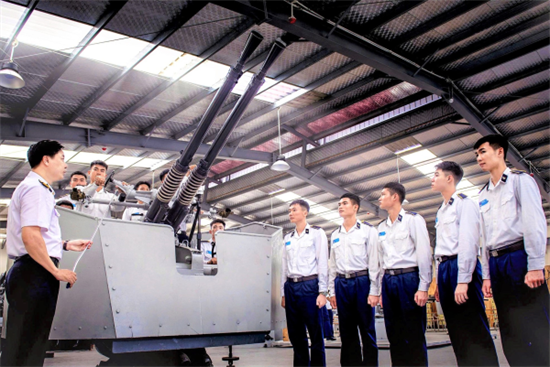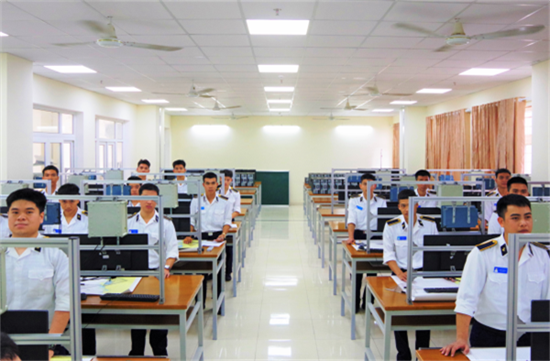Solutions to promote application of science, technology, and digital transformation in raising the quality of education and training at Naval Academy
Amid robust advances in science and technology and a growing need for digital transformation, in order to raise the quality of education and training at Naval Academy, application of science and technology and promotion of innovation and digital transformation become a matter of urgency, requiring further researches and breakthrough, effective solutions.
In recent years, the Naval Academy has well performed its role as the “spearhead force” in training and developing high-quality human resources for the Navy, meeting the requirement of firmly safeguarding national sovereignty over seas and islands. However, the rapid development of science and technology and the modernisation of the Navy have posed new challenges to education and training, particularly in improving learners’ capability to master modern weapons and technologies and effectively conduct operations in complex, integrated environments.
 |
| Giving instructions on how to use naval artillery to cadets |
Against that backdrop, in line with the standpoint by the Navy’s Party Committee and Command on developing and further applying science, technology, innovation, and digital transformation as the key factor in building a revolutionary, regular, highly-skilled, modernised Navy, the Academy has seen science and technology development, innovation, and digital transformation as the “key” to raising the quality of education and training to meet mission requirements. From the Academy’s education and training realities, several main solutions are proposed within this article.
First, formulating and perfecting mechanisms and policies to strengthen leadership and direction over breakthroughs in science, technology, and digital transformation in education and training. This is a fundamental solution, serving as a driving force and creating a favourable environment for technology application, innovation, and digital transformation within the Academy today. Regulations and policies for investment, procurement, management, and effective use of digital infrastructures and hi-tech equipment for education and research as well as for recruiting, attracting, and utilising high-calibre human resources in science, technology, and digital transformation should be established in advance. Priority should be given to simplifying administrative procedures and creating favourable conditions for adopting new technologies and innovative digital education models. Importance should be attached to mechanisms and policies to encourage technology research, application, and transfer in parallel with intellectual property protection and effective exploitation of digital products, learning materials, and simulation software across the Academy. Financial mechanisms should be reformed flexibly, with priority given to allocating budget for key projects aim at developing digital infrastructures, laboratories, simulation centres, and high-quality digital learning resources.
Grounded on those above-mentioned mechanisms and policies, all-level party committees and commands across the Academy should strengthen their leadership and direction with high political resolve and a breakthrough vision. Each office and unit across the Academy should proactively develop action plans including specific road map and duties, regularly carry out inspection work, and heighten a sense of responsibility at each stage and step to promptly detect and resolve any difficulties and obstacles. Resources should be prioritised for the core components of digital transformation, such as network infrastructures, terminal equipment, common digital platforms, Learning Management System (LMS), Management Information System (MIS), and complex, specialised simulation software. Moreover, it is necessary to develop digital culture, awareness, and skills among cadres, lecturers, employees, and cadets.
Second, building and developing high-quality human resources, especially in key areas. Comprehensive investment in high-calibre human resources is the cornerstone for turning each individual into a driving force of digital transformation and modernisation of the education and training process. At the Naval Academy, high-quality human resources include lecturers, scientists, managers, technical staff, support personnel, and cadets. For lecturers, scientists, and managers, there should be a master strategy encompassing recruitment, training, professional development, and incentive policies. Recruitment policies should be good enough to attract talented individuals, particularly experts in information technology, data science, artificial intelligence (AI), cybersecurity, and key military technical fields. Besides, retraining and professional development for this contingent should be prioritised to update them on specialised knowledge, improve their pedagogical skills, and enhance their capabilities in using and applying technologies and digital platforms at every step of the teaching process. It is important to build a favourable working environment to enable them to access advanced technologies, conduct large-scale research projects, address real-world challenges, and transfer research outcomes to the training process. For technical cadres and specialised employees, who play a core role in operating, maintaining, and mastering the Academy’s digital infrastructures, simulation systems, and modern laboratories, there should be specialised training plans to regularly update them on new technologies.
 |
| Training at a specialised classroom |
For cadets, in order to achieve the goal of developing a generation of naval officers with “digital mindset” and strong capability in applying science and technology, it is essential to integrate information technology, data science, cybersecurity, and other relevant technologies into training programs from early stages. Teaching and learning methods should be renewed to develop self-study and problem-solving skills in digital environments and enable learners to quickly adapt to technological changes. An interactive learning environment should be formed with the use of modern digital platforms to help learners become familiar with and proficient in digital tools right in their learning process.
Third, renewing training content, curricula, and methods towards modernity and practical application. This is a key step to integrate science, technology, and digital transformation into every lecture, lesson, and practical activity. Training content and curricula should be reviewed, updated, and developed to closely follow the rapid development of global and domestic military science and technology with great potential for extensive application in the naval field. They must timely reflect the latest advances in the structure, operational principles, exploitation, maintenance, repair, and tactical features of new, modern weapons and technical equipment that the Navy currently possesses or will be provided with. At the same time, it is necessary to organise courses with knowledge from various fields, such as digital transformation, cybersecurity, big data management, and AI application in the Military to allow learners to develop a systematic, comprehensive vision, improve their capabilities to solve complex real-world problems, and equip them with digital thinking, skills, and problem-solving capacity in digital environments amid rapid scientific and technological changes.
Furthermore, due attention should be paid to adopting modern training methods, placing learners at the centre of the training process, and increasing interaction and application of technology. It is essential to integrate modern simulation systems, practice centres, and technologies deeply into the curricula to create role-play, visual learning environments, thereby helping learners acquire knowledge easily, practise complex actions, and handle dangerous scenarios before working with real equipment. Problems-based teaching, case studies, projects-based teaching, and extra-curricular activities should be intensified to foster learners’ initiative, creativity, and teamwork and problem-solving skills. Digital transformation should be applied in teaching to maximise the effectiveness of learning management systems, interactive e-lessons, multimedia materials, and online two-way interactive tools for holding hybrid courses and flexibly combining face-to-face and online learning.
Testing and learning outcome evaluation should be reformed with the application of digital technology and diverse methods to accurately measure learners’ actual competencies. This can be achieved through learners’ activities on LMS, online debates, and simulation systems, or via the use of online testing software with diverse question banks in order to ensure objectivity and fairness and provide timely feedback for learners to adjust their learning methods properly.
Fourth, continuing to promote applied science research and the transfer of research outcomes to facilitate the education and training process. Emphasis should be placed on identifying key research directions and highly applicable topics relevant to the use of modern weaponry, naval warfare art in hi-tech environments, and issues emerging from digital transformation, such as application of AI in intelligence analysis and maritime cybersecurity, optimisation of vessel operations using big data, and development of command and control systems on digital platforms. Cadres, lecturers, and cadets should be encouraged to engage in science research, while consideration should be given to building interdisciplinary research groups comprised of lecturers, technical staff, and outstanding cadets. Due regard should be paid to developing modern facilities and equipment and encouraging the release of research findings in reputable domestic and international scientific journals.
Additionally, it is important to establish mechanisms, policies, and procedures to ensure the rapid, effective transfer of research outcomes. The process of integrating scientific research results into lectures, curricula, and reference materials should be accelerated; training models, teaching aids, and simulation software that help directly address technical and tactical issues emerging from grass-roots units should be developed. It is vital to maintain close cooperation with grass-roots units and specialised research institutes with great potential in science and technology from both inside and outside the Military so as to promote applied research and put research findings into practice.
Comprehensively, effectively applying science, technology, and digital transformation to teaching, training, and science research is an inevitable path and will directly contribute to raising the Naval Academy’s training quality and building the Academy into a “smart, standardised, and modern institution” capable of affirming its position and prestige as one of the leading centres for training and science research within the Navy and across the nation.
Sr. Col. PHAN THANH CHUNG, PhD
Sr. Col. BUI SY HUY, MA
Naval Academy